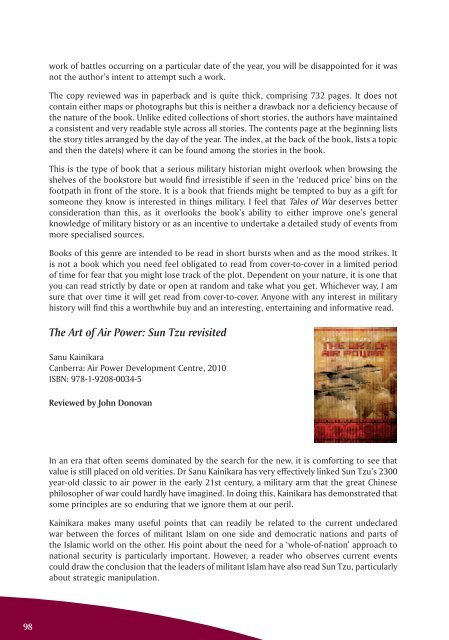ISSUE 183 : Nov/Dec - 2010 - Australian Defence Force Journal
ISSUE 183 : Nov/Dec - 2010 - Australian Defence Force Journal
ISSUE 183 : Nov/Dec - 2010 - Australian Defence Force Journal
You also want an ePaper? Increase the reach of your titles
YUMPU automatically turns print PDFs into web optimized ePapers that Google loves.
work of battles occurring on a particular date of the year, you will be disappointed for it wasnot the author’s intent to attempt such a work.The copy reviewed was in paperback and is quite thick, comprising 732 pages. It does notcontain either maps or photographs but this is neither a drawback nor a deficiency because ofthe nature of the book. Unlike edited collections of short stories, the authors have maintaineda consistent and very readable style across all stories. The contents page at the beginning liststhe story titles arranged by the day of the year. The index, at the back of the book, lists a topicand then the date(s) where it can be found among the stories in the book.This is the type of book that a serious military historian might overlook when browsing theshelves of the bookstore but would find irresistible if seen in the ‘reduced price’ bins on thefootpath in front of the store. It is a book that friends might be tempted to buy as a gift forsomeone they know is interested in things military. I feel that Tales of War deserves betterconsideration than this, as it overlooks the book’s ability to either improve one’s generalknowledge of military history or as an incentive to undertake a detailed study of events frommore specialised sources.Books of this genre are intended to be read in short bursts when and as the mood strikes. Itis not a book which you need feel obligated to read from cover-to-cover in a limited periodof time for fear that you might lose track of the plot. Dependent on your nature, it is one thatyou can read strictly by date or open at random and take what you get. Whichever way, I amsure that over time it will get read from cover-to-cover. Anyone with any interest in militaryhistory will find this a worthwhile buy and an interesting, entertaining and informative read.The Art of Air Power: Sun Tzu revisitedSanu KainikaraCanberra: Air Power Development Centre, <strong>2010</strong>ISBN: 978-1-9208-0034-5Reviewed by John DonovanIn an era that often seems dominated by the search for the new, it is comforting to see thatvalue is still placed on old verities. Dr Sanu Kainikara has very effectively linked Sun Tzu’s 2300year-old classic to air power in the early 21st century, a military arm that the great Chinesephilosopher of war could hardly have imagined. In doing this, Kainikara has demonstrated thatsome principles are so enduring that we ignore them at our peril.Kainikara makes many useful points that can readily be related to the current undeclaredwar between the forces of militant Islam on one side and democratic nations and parts ofthe Islamic world on the other. His point about the need for a ‘whole-of-nation’ approach tonational security is particularly important. However, a reader who observes current eventscould draw the conclusion that the leaders of militant Islam have also read Sun Tzu, particularlyabout strategic manipulation.98
















